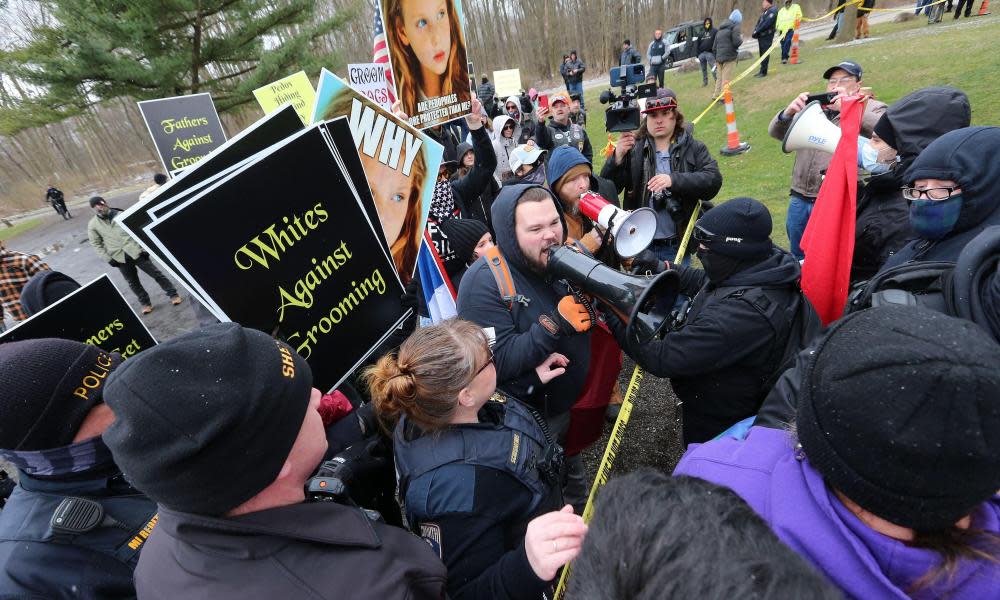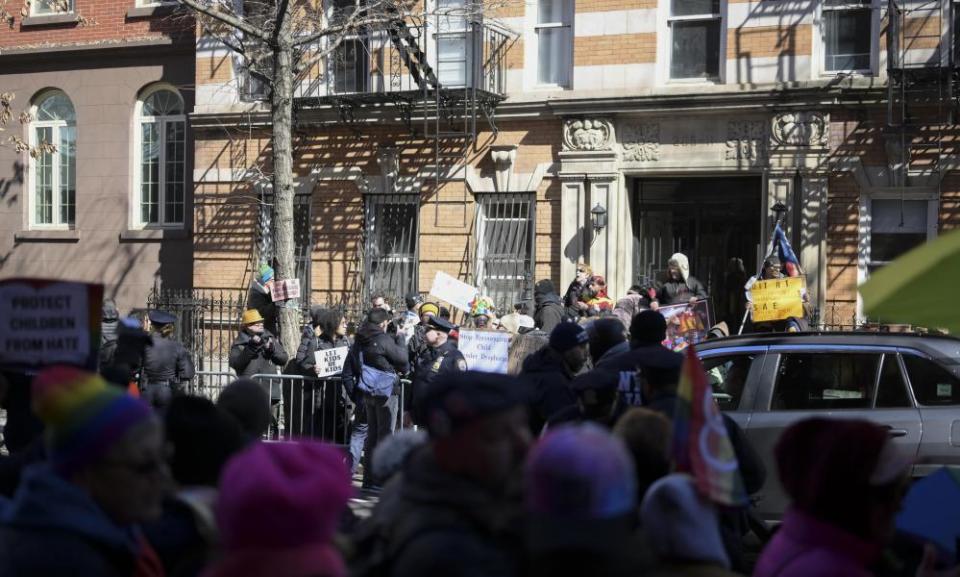Drag storytellers grapple with growing threats by Republicans and far right

In a sea of rainbow umbrellas, colorful hairstyles, and even brighter costumes, Allison Towle loosely gripped onto her five-year-old daughter’s hand.
It was bright and cold in New York’s West Village, and the two were on their way out from a Drag Storytelling Hour.
Hosted by the city’s attorney general, Letitia James, at the LGTBQ+ community center, these events – popular nationally in the US – have become an informational way of exposing children to new books and ways of thinking. And the pair had a great time, planning to return.
“I want to teach her that she can wear whatever, love whoever, be whoever,” Towle said, patting the flower garland on top of her daughter’s blonde hair.
But drag story hours are no longer simple in the US. They have been targeted by Republicans and the far-right with protests and threats of violence and wild conspiracy theories around grooming and abuse. At the same, there has been a concerted legislative push to erode LGBTQ rights in state legislatures across the US, an effort to remove LGBTQ literature from public libraries and rising acts of violence against the community.
So it was perhaps no surprise that James’s Greenwich Village event found itself picketed by far-right protesters. As chants coming from protesters who had gathered on the other side of the tree-lined street to the event grew louder and more aggressive – Towle’s grip on her child tightened.

When a man opened the window of his second-floor apartment and pinned a sign to his fire escape supporting the drag community, tensions rose higher. He quickly shut it again, and the police – already standing in the middle – spread out, braced, and waited for backup.
“This is terrifying,” Towle said, standing back towards the back of the crowd.
Scenes of conflict at these events have become common place across the US.
A recent reading in Wandsworth, Ohio, was interrupted when hundreds of protesters stormed the event in the city’s Memorial Park. Racial slurs were yelled from behind metal barricades, pepper spray – dispersed into the air – and a weapon resembling a gun, pointed at the crowd.
The drag storyteller, who tried to continue, was eventually drowned out by a chorus of “Seig Heil” and “‘there will be blood”. As police sirens sounded, families had to flock past men wearing face masks and holding swastikas in order to leave. Many reported being followed on their way out.
In Arizona a coffee shop recently shut down its story hour after it received a bomb threat just before it began. Police searched the store but found no device. Protesters, including Proud Boys, were near the establishment when the threat was made.
In Florida an LGBTQ center canceled its event due to threats from hate groups. “We take these threats very seriously and would not want to endanger or expose children and their parents and guardians to bigotry and hate,” the center said in a statement.
“The far-right and conspiracy theorists have just pivoted their focus,” said Mia Bloom, a Georgia State University professor and author of Pastels and Paedophiles, a book on the far-right QAnon conspiracy movement.
“They’ve made issues like school curriculum and story hour part of a culture war, a way in which they can whip up support.”
Indeed, when members of the Proud Boys, an often violent US extremist group, turned up at the protest in New York on Sunday, their motivations for being there, other than to incite violence, were unclear.
One member, seen walking away from the chaos with blood streaming down his face, claimed he’d only come “to help”. Supporters shouted at him to go back to Long Island.
With Tennessee newly banning “adult cabaret performances” and 32 other states filing similar bills, critics of events like drag story hours now have laws which validate and speak to their concerns.
Some, like Angelica, a woman at the New York rally, just attend these protests because of personal volition. “I don’t think it’s right for children to be exposed,” she said, standing on the steps of a brownstone nearby. “I support drag, but they’re just so young. I can’t comprehend it.”
Others, like the Proud Boys, are part of a larger, organized political group. Still, these critics often share universal fears with forms of expression that defy traditional gender roles. And the notion that these readings are somehow indoctrinating children with leftist views.
Jay Brown, a senior vice-president at the Human Rights Campaign, quickly drew attention to the 420 broader anti-LGBTQ+ laws currently being debated in statehouses across the US.
“Let’s be clear that drag isn’t a threat to anybody’s safety,” he commented in relation to the recent protests.
“But the political assault that the larger LGBTQ+ community is facing should scare us all.”
Fear was undoubtedly felt in the West Village on Sunday. The community center sits in an area with deep symbolic ties to the birthplace of the LGBTQ+ movement, only a few minutes walk from the historic Stonewall Inn.
Sean, who had been at the frontline of the action since earlier in the morning, was attending partly because he wanted to counter that fear.
“As a gay man, I cannot stand by and allow people with hatred in their hearts to go against my community again and again,” he said, raising his voice over the ringing of bells.
“As an Oklahoma native, I’m shocked I couldn’t get further away from all of this.”
Turning back towards the protesters facing him on the opposite side of the street, he paused again briefly.
“We have such a long way to go in the US.”

 Yahoo News
Yahoo News 
